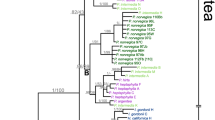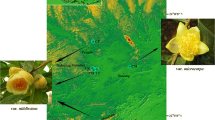Abstract
Chamaesyce skottsbergii var. skottsbergii is federally listed as an endangered taxon, and is found in small and isolated populations restricted to calcareous soils in dry shrubland habitats on the Hawaiian islands of Oahu and Molokai. Concern over the genetic relationship among these disjunct populations arose as a result of threats to the habitat of the Oahu population. The populations were examined using random amplified polymorphic DNA (RAPD) markers and sequence analysis of the internal transcribed spacer (ITS) region of the rDNA cistron. Chamaesyce skottsbergii var. vaccinioides, a closely related variety found in several small populations on Molokai, was used for baseline comparison of the genetic divergence among populations. RAPD analysis demonstrated that variation within and among populations is the highest for any Hawaiian species examined. Polymorphism was greater than 95% within populations and was 99.4% at the species level. Similarly, measures of genetic similarity indicate that differentiation among these populations is higher than is known for some species. Both RAPD and ITS sequence analysis indicate that populations of C. skottsbergii var. skottsbergii on Oahu and Molokai are genetically distinct, and the extent of this genetic differentiation supports the recognition of these populations as distinct varieties. The Molokai population is in fact much more closely related to var. vaccinioides than to var. skottsbergii on Oahu, and thus should be recognized by the previously used variety name, C. skottsbergii var. audens. Further conservation measures for each of the varieties are addressed.
Similar content being viewed by others
References
Ballard HE Jr, Sytsma KJ (2000) Evolution and biogeography of the woody Hawaiian violets (Viola, Violaceae): arctic origins, herbaceous ancestry and bird dispersal. Evolution 54: 1521–1532
Baskin CC, Baskin JM, Yoshinaga A, Cordell S, Drake D, Gleason S, Welton P (2004) Seed germination ecology of Hawaiian montane species: a continuation of efforts to acquire, organize, and share data to facilitate propagation and restoration efforts. Hawaii Conservation Alliance. (http://www.hawaii.edu/scb/docs/formats/pdf/Seeds0203.pdf)
Caraway V (1997) Hybridization, introgression and speciation among Dubautia species (Asteraceae: Madiinae). MS thesis, University of Hawaii, Honolulu
Caraway V, Carr GD, Morden CW (2001) Assessment of hybridization and introgression in lava-colonizing Hawaiian Dubautia (Asteraceae: Madiinae) using RAPD markers. Am. J. Bot. 88: 1688–1694
Carr GD, Powell EA, Kyhos DW (1986) Self-incompatibility in the Hawaiian Madiinae (Compositae): an exception to Baker’s rule. Evolution 40: 430–434
Char W (1981) Ecological and horticultural studies of Euphorbia skottsbergii at Barbers Point, Oahu, Hawaii. US Army Corp of Engineers Contract DAWC84-80-C-0017
Crandall KA, Bininda-Emonds ORP, Mace GM, Wayne RK (2000) Considering evolutionary processes in conservation biology. Trends Ecol. Evol. 15: 290–295
DeJoode DR, Wendel JF (1992) Genetic diversity and origin of the Hawaiian Islands cotton, Gossypium tomentosum. Am. J. Bot. 79: 1311–1319
Doyle JJ, Doyle JL (1987) A rapid DNA isolation procedure for small quantities of fresh leaf tissue. Phytochem. Bull. 19:11–15
Ellstrand NC, Elam DR (1993) Population genetic consequences of small population size: implications for plant conservation. Annu. Rev. Ecol. Syst. 24:217–242
Felsenstein J (1985) Confidence limits on phylogenies: an approach using the bootstrap. Evolution 39: 783–791
Fenster CB, Dudash MR (1996) Genetic considerations for plant population restoration and conservation. In: Bowles ML, Whelan CJ (eds) Restoration of Endangered Species: Conceptual Issues, Planning and Implementation. Cambridge University Press, Cambridge, pp. 34–62
Frankham R (1997) Do island populations have less genetic variation than mainland populations?. Heredity 78:311–327
Frankham R, Ballou JD, Briscoe DA (2002) Introduction to Conservation Genetics. Cambridge University Press, Cambridge
Friar EA, Robichaux RH, Mount DH (1996) Molecular genetic variation following a population crash in the endangered Mauna Kea Silversword, Argyroxiphium sandwicense subsp. sandwicense (Asteraceae). Mol. Ecol. 5:687–691
Gitzendanner MA, Soltis PS (2000) Patterns of variation in rare and widespread plant congeners. Am. J. Bot. 87:783–792
Givnish TJ, Sytsma KJ, Smith JF, Hahn WJ (1995) Molecular evolution, adaptive radiation, and geographic speciation in Cyanea (Campanulaceae, Lobelioideae). In: Wagner WL, Funk VA (eds), Hawaiian Biogeography, Evolution on a Hot Spot Archipelago. Smithsonian Institution Press, Washington, pp. 288–337
Hamrick JL, Godt MJW (1990) Allozyme diversity in plant species. In: Brown ADH, Clegg MT, Kahler AL, Weir BS (eds), Plant Population Genetics, Breeding and Genetic Resources. Sinauer Associates, Inc., Massachusetts, pp. 43–66
Hamrick JL, Godt MJW, Murawski DA, Loveless MD (1991) Correlations between species traits and allozyme diversity: implications for conservation biology. In: Falk DA, Holsinger KE (eds), Genetics and Conservation of Rare Plants. Oxford University Press, Oxford, pp. 75–86
Harbin SC (2003) Measures of fitness and genetic variation in the endangered Hawaiian genus Hesperomannia. MS thesis, University of Hawaii, Manoa
Hartl DL, Clark AG (1989) Principles of Population Genetics, 2nd edn. Sinauer, Sunderland UK
Howarth DG, Gardner DE, Morden CW (1997) Phylogeny of Rubus subgenus Idaeobatus (Rosaceae) and its implications toward colonization of the Hawaiian Islands. Syst. Bot. 22, 433–441
Koutnik DL (1987) A taxonomic revision of the Hawaiian species of the genus Chamaesyce (Euphorbiaceae). Allertonia 4:331–388
Koutnik DL (1999) Chamaesyce S. F. Gray, spurge. (native species). In: Manual of the flowering plants of Hawai‘i, rev. edn. (eds. Wagner WL, Herbst DR, Sohmer SH), pp. 602–617. University of Hawai‘i Press and Bishop Museum Press, Honolulu, HI
Kovach Computing Services (1987–1998) Multi-variate Statistical Package, v. 3.0. Pentraeth, Wales
Kwon JA, Morden CM (2002) Population genetic structure of two rare tree species (Colubrina oppositifolia and Alphitonia ponderosa, Rhamnaceae) from Hawaiian dry and mesic forests using RAPD markers. Mol. Ecol. 11:991–1001
Loeffler W, Morden CW (2003) Genetic diversity and biogeography of the Hawaiian cordage plant, olona (Touchardia latifolia; Urticaceae), based on RAPD markers. Biochem. Syst. Ecol. 31:1323–1335
Lynch M, Milligan BG (1994) Analysis of population genetic structure with RAPD markers. Mol. Ecol. 3:91–99
Minitab (1996) MINITAB Reference Manual and User’s Guide, Release 11. State College, PA
Morden CW, Caraway V, Motley TJ, (1996) Development of a DNA library for native Hawaiian plants. Pac. Sci. 50:324–335
Morden CW, Loeffler W (1999) Fragmentation and genetic differentiation among subpopulations of the endangered Hawaiian mint Haplostachys haplostachya (Lamiaceae). Mol. Ecol. 8:617–625
Morden CW, Gardner DE, Weniger DA (2003) Phylogeny and biogeography of Pacific Rubus subgenus Idaeobatus (Rosaceae) species: investigating the origin of the endemic Hawaiian raspberry R. macraei. Pac. Sci. 57:181–197
Motley TJ (1996) Biosystematics and reproductive biology of the endemic Hawaiian genus LabordiaGaud. (Loganiaceae). PhD dissertation, University of Hawaii, Honolulu
Motley TJ, Carr GD (1998) Artificial hybridization in the Hawaiian endemic genus Labordia (Loganiaceae). Am. J. Bot. 85:654–660
Nei M, Li WH (1979) Mathematical model for studying genetic variation in terms of restriction endonucleases. Proc. Natl. Acad. Sci. USA 76:5269–5273
Randell RA, Morden CW, (1999) Hawaiian plant DNA library II: endemic, indigenous, and introduced species. Pac. Sci. 53:401–417
Sambrook J, Fritsch EF, Maniatis T (1989) Molecular Cloning: A Laboratory Manual, 2nd edn. Cold Spring Harbor Laboratory Press, New York
Sherff EE (1937) Revision of the Hawaiian species of Euphorbia L. Ann. Miss. Bot. Gard. 25:1–94
Swofford DL (1996) PAUP: Phylogenetic Analysis Using Parsimony (and other methods). Sinauer Associates, Sunderland, Massachusetts
Templeton AR (1997) Coadaptation, local adaptation, and outbreeding depression. In: Meffe GK, Carroll CR (eds), Principles of Conservation Biology. Sinauer Associates, Inc., Massachuestts, pp. 171–172
Wendel JF, Schnabel A, Seelanan T (1995) An unusual ribosomal DNA sequence from Gossypium gossypioides reveals ancient, cryptic, intergenomic introgression. Mol. Phylogenet. Evol. 4:298–313
Whistler A (1998) Chamaesyce skottsbergii botanical survey of the naval air station, Barbers Point, Oahu, Hawaii. Belt Collins Hawaii
Whistler A (2003) `Akoko (Chamaesyce skottsbergii var. kalaeloana) survey of the “northern trap and skeet range” at former Naval Air Station, Barbers Point. Isle Botanica, Navy Contract DAMD17-03-2-0022
Ziegler AC (2002) Hawaiian Natural History, Ecology, and Evolution. University of Hawai‘i Press, Honolulu, HI
Acknowledgements
We thank James Kwon for bringing this project to our attention and for assisting with collection of material, Winona Char for our discussions on Chamaesyce systematics, Alison Sherwood for assistance with analyses, and Joanne Birch, Susan Mazer, Tim Motley, Alison Sherwood, and an anonymous reviewer for helpful comments on the manuscript. Research was supported by funding from the U.S. Fish & Wildlife Service and USGS Cooperative Parks Studies Unit, University of Hawaii.
Author information
Authors and Affiliations
Corresponding author
Rights and permissions
About this article
Cite this article
Morden, C.W., Gregoritza, M. Population variation and phylogeny in the endangered Chamaesyce skottsbergii (Euphorbiaceae) based on RAPD and ITS analyses. Conserv Genet 6, 969–979 (2005). https://doi.org/10.1007/s10592-005-9087-4
Received:
Accepted:
Published:
Issue Date:
DOI: https://doi.org/10.1007/s10592-005-9087-4




